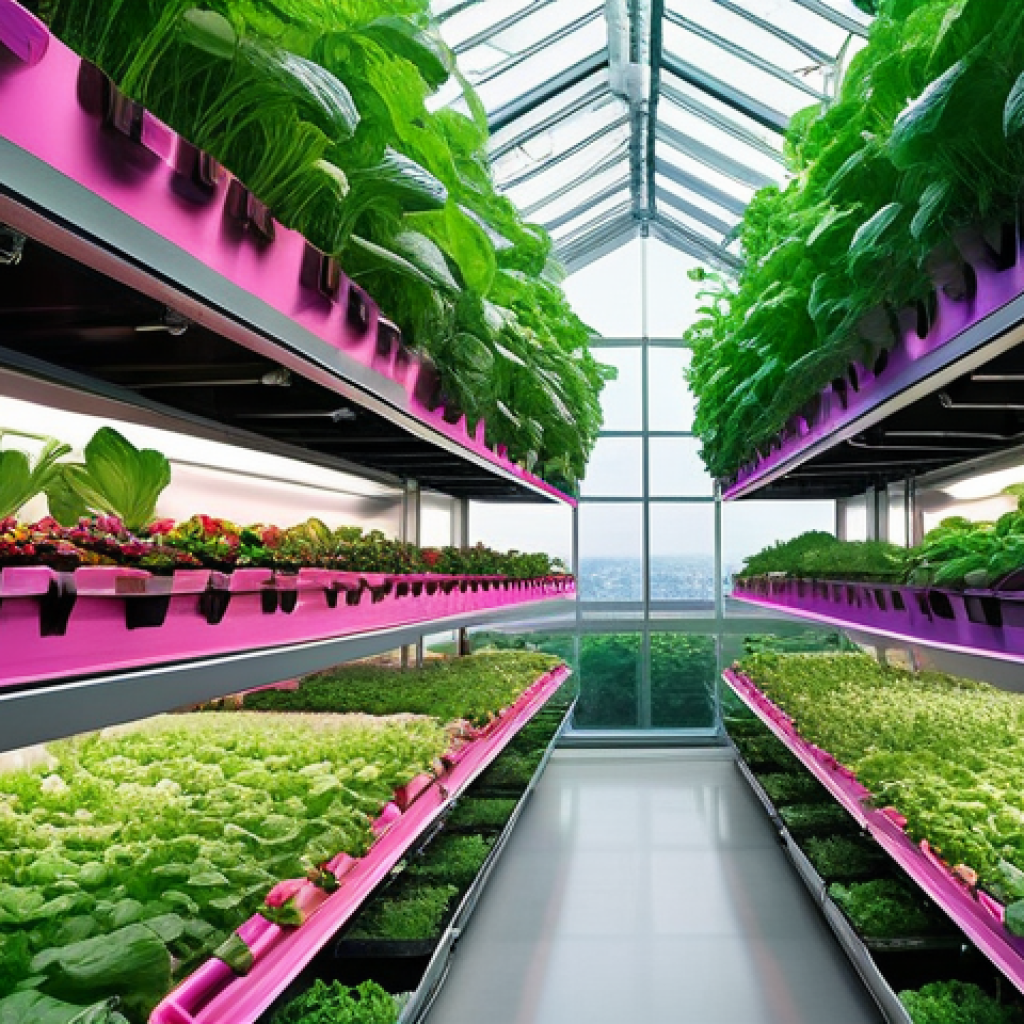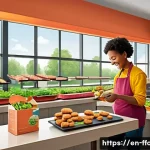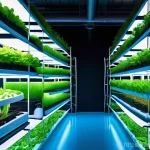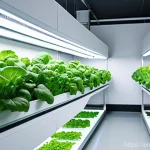Hey there, amazing readers! Have you ever stopped to think about where our food truly comes from and the journey it takes to get to our plates? With a growing global population, it feels like the pressure on our planet to feed everyone is increasing exponentially.
But here’s something truly exciting: the world of food production is undergoing a massive, incredible transformation, and it’s all thanks to some seriously clever, environmentally friendly technologies that are emerging right now.
I’ve been absolutely captivated by how innovators are tackling this challenge, not just making things more efficient, but genuinely kinder to Mother Earth.
From towering vertical farms that are bringing fresh produce right into our cities, completely transforming urban landscapes and drastically cutting down on water and land use, to precision agriculture that uses AI and smart sensors to ensure every plant gets exactly what it needs without waste, it’s clear we’re on the cusp of a food revolution.
And honestly, it’s not just about reducing our footprint; it’s about creating healthier, more resilient food systems for generations to come. I’ve personally seen how these advancements are changing the game, making our food safer, more sustainable, and truly innovative.
It’s a game-changer for how we think about our daily meals. Let’s explore these groundbreaking advancements and uncover the fascinating future of how we’ll eat!
Sky-High Harvests: The Rise of Vertical Farms
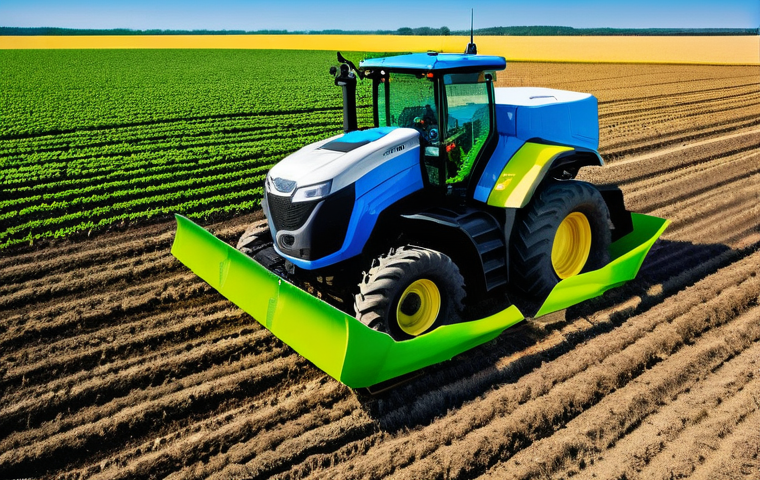
Honestly, when I first heard about vertical farms, my mind conjured images straight out of a sci-fi movie – towering structures brimming with plants, all under artificial lights. And guess what? It’s not far off! I’ve been absolutely fascinated watching this technology evolve. These aren’t just pretty concepts; they’re revolutionizing how we get our greens, especially in densely populated urban areas where traditional farming is just a pipe dream. Imagine fresh, crisp lettuce, vibrant herbs, and juicy strawberries grown right in the heart of your city, completely independent of the seasons or unpredictable weather. It’s a game-changer for local food supply, slashing the distance food travels from farm to plate, which means less carbon footprint and incredibly fresh produce hitting your grocery store shelves. I’ve tasted basil from a local vertical farm, and let me tell you, the difference in flavor and vibrancy is palpable – it’s like a burst of summer, even in the dead of winter!
Bringing Freshness to Our Doorsteps
One of the biggest wins I’ve seen with vertical farming is its incredible ability to bring ultra-fresh produce directly into our communities. Think about it: no more trucking vegetables across thousands of miles, burning fuel and losing freshness along the way. Instead, these farms are popping up in converted warehouses, old factories, and even within existing buildings, making fresh, nutrient-dense food accessible to everyone. This means a quicker journey from harvest to your home, often within hours, not days. From my own experience, buying produce grown this way feels different – there’s a sense of connection to where my food comes from, even if it’s just a few blocks away. It’s incredibly empowering to know that sustainable, high-quality food is being cultivated right around the corner, contributing to a healthier, more resilient local food system.
Radical Resource Efficiency
What truly blows my mind about vertical farming isn’t just the urban convenience, but the mind-boggling efficiency in resource use. These systems typically use up to 95% less water than traditional field farming. Can you believe that? It’s achieved through closed-loop hydroponic or aeroponic systems where water is recirculated, meaning virtually no waste. Plus, because it’s a controlled environment, there’s no need for pesticides or herbicides, making the produce naturally organic and safer for us to eat. I remember visiting a small vertical farm downtown, and the air inside was so clean, the plants so vibrant – it felt like a glimpse into a healthier future. This level of sustainability is crucial for our planet, especially as water scarcity becomes a more pressing global issue. It’s not just about growing food; it’s about growing it smart.
Smart Fields: Precision Agriculture Takes the Helm
If you’ve ever felt overwhelmed by the sheer scale of modern agriculture, you’re not alone. But here’s where things get seriously exciting: precision agriculture is stepping in to make farming not just more efficient, but incredibly intelligent and environmentally kind. I’ve been following the developments in this field with genuine awe, watching how farmers are now using cutting-edge technology to understand their land and crops like never before. We’re talking about drones scouting fields, AI-powered sensors monitoring soil health down to the microbe, and GPS-guided machinery applying water and nutrients with pinpoint accuracy. It’s like giving every single plant its own personal care plan! This isn’t just about bigger yields; it’s about minimizing waste, reducing environmental impact, and ensuring that every resource is used exactly where and when it’s needed. For me, it’s a huge relief to see technology being harnessed to create a more harmonious relationship between farming and nature.
Optimizing Every Drop and Grain
The core of precision agriculture really boils down to doing more with less, but in a ridiculously smart way. Instead of broad applications of fertilizers or water across an entire field, which inevitably leads to runoff and waste, smart systems analyze specific areas and deliver exactly what’s required. Picture this: a sensor detects a dry patch in a field, and only that patch gets watered. Or, it identifies a nutrient deficiency in a tiny section of soil, and only that section receives fertilizer. I’ve heard stories from farmers who’ve adopted these methods, and they consistently talk about massive reductions in water usage and chemical inputs, all while maintaining or even improving their crop quality. It’s not just eco-friendly; it’s also incredibly cost-effective, which is a win-win for everyone involved. It’s truly a testament to how intelligent design can solve complex environmental challenges.
The Power of Data and AI on the Farm
At the heart of precision agriculture’s success is an intricate dance between data collection and artificial intelligence. Farmers are no longer just relying on their gut feeling or traditional methods; they’re equipped with real-time insights that guide their decisions. Drones with hyperspectral cameras can spot crop diseases before they’re visible to the human eye, AI algorithms can predict ideal planting times based on weather patterns and soil data, and robotic systems can even weed fields, reducing the need for herbicides. It’s a complete transformation! I’ve personally seen how a farm that implemented these technologies managed to bounce back from a challenging season by making data-driven adjustments that saved their harvest. This fusion of tech and agriculture is not just about efficiency; it’s about creating a truly resilient and responsive food system that can adapt to future challenges with grace and intelligence.
Beyond the Barn: Cultivated Meat and Alternative Proteins
Okay, let’s talk about something that might sound a bit futuristic, but is rapidly becoming a delicious reality: cultivated meat and alternative proteins. I know, “meat grown in a lab” might sound a little out there, but hear me out! The traditional way we produce meat has a colossal environmental footprint, from land use to greenhouse gas emissions. That’s why I’m genuinely excited about the innovators who are finding new ways to put protein on our plates without such a heavy toll on the planet. I’ve tried some of these alternative protein products myself – plant-based burgers, chicken nuggets made from fungi – and honestly, some of them are incredibly convincing and absolutely delicious. This isn’t just a trend; it’s a fundamental shift in how we think about feeding a growing global population sustainably. It’s about creating choices that are better for us, better for animals, and significantly better for Mother Earth.
Meat Without the Moo: The Cultivated Revolution
The concept of cultivated meat (sometimes called lab-grown or cell-based meat) is revolutionary. Imagine taking a small sample of animal cells, and then, in a controlled environment, nurturing those cells to grow into actual meat, muscle fibers and all, without ever needing to raise and slaughter an animal. It sounds wild, right? But it’s happening, and the potential impact is enormous. Think about the massive reduction in land and water use, not to mention the significant cut in greenhouse gas emissions compared to conventional livestock farming. While it’s still in its early stages of commercialization, the idea of having truly sustainable, ethical meat options readily available is incredibly appealing. I’ve read about the taste tests, and many can’t tell the difference! For someone like me who loves a good burger but worries about its environmental cost, this offers a really hopeful path forward.
Protein Power: Unleashing Plant-Based and Novel Alternatives
Beyond cultivated meat, the world of alternative proteins is exploding with innovation. We’re seeing incredible advancements in plant-based proteins, with companies creating everything from delicious dairy-free cheeses that actually melt to plant-based seafood that tastes shockingly like the real thing. But it doesn’t stop there! Novel proteins derived from fungi, algae, and even insects are gaining traction, offering highly sustainable and nutrient-dense food sources. I’ve personally experimented with cooking with various plant-based meat substitutes, and honestly, the quality and variety available now are astounding compared to even five years ago. It’s not just about replicating meat; it’s about creating entirely new culinary experiences that are both delicious and environmentally responsible. This shift gives us more options at the grocery store, allowing us to make more conscious choices about what we consume.
Healing Our Earth: Agroecology and Regenerative Practices
Walking through fields managed with agroecology and regenerative farming principles feels fundamentally different. The soil hums with life, the air is alive with the buzz of pollinators, and there’s a tangible sense of balance. This isn’t just about tweaking existing farming methods; it’s about a complete philosophical shift towards working *with* nature, not against it. I’ve been incredibly inspired by farmers who are embracing these practices, moving away from chemical-intensive agriculture towards systems that actively heal the land. It’s about building healthy soil, fostering biodiversity, and creating robust, resilient ecosystems that can withstand climate challenges. When you see the difference in soil quality, the vibrancy of the plants, and the return of wildlife to these farms, it’s impossible not to feel hopeful. This approach isn’t just sustainable; it’s actively restorative, leaving the land in a better state for future generations. It’s a return to wisdom, enhanced by modern understanding.
Bringing Life Back to the Soil
The heart of regenerative agriculture lies in its obsession with soil health. Forget sterile dirt; we’re talking about living, breathing soil teeming with microbes, fungi, and worms, all working together to nourish plants naturally. Practices like no-till farming, cover cropping, and diverse crop rotations are key. By disturbing the soil as little as possible, keeping it covered, and planting a variety of crops, farmers are rebuilding the organic matter that acts like a sponge, holding water and nutrients. I’ve visited farms where, after just a few years of regenerative practices, the soil transformed from barren to rich and dark, bursting with life. It’s a stark contrast to conventional fields that often resemble dusty moonscapes. Healthy soil doesn’t just grow healthier plants; it also sequesters carbon from the atmosphere, making it a powerful tool in combating climate change. It’s like giving the earth a much-needed spa day, every single day.
Embracing Nature’s Diversity
Another beautiful aspect of agroecology is its deep commitment to biodiversity. Instead of monocultures – vast fields of a single crop – these systems integrate a rich tapestry of plants, animals, and insects. This means planting hedgerows for beneficial insects, introducing livestock to graze and fertilize the land, and cultivating a mix of crops that support each other. This diversity creates a more stable and resilient farm ecosystem, naturally controlling pests and diseases, and reducing the reliance on external inputs. I’ve always felt that nature thrives on diversity, and it’s wonderful to see farming practices reflect that wisdom. When you see bees buzzing among wildflowers interspersed with crops, or chickens scratching around in pastures, it just feels right. It’s about creating a holistic system where every element plays a vital role, fostering a vibrant and productive environment for all.
Soilless Solutions: Hydroponics and Aeroponics Unveiled
Imagine growing food without a single speck of soil. Sounds a bit otherworldly, doesn’t it? Yet, hydroponics and aeroponics are doing exactly that, and they’re becoming absolute powerhouses in sustainable food production. I’ve always been fascinated by how these “soilless” methods manage to cultivate incredibly healthy, fast-growing plants using dramatically less water and space. It’s not just a clever trick; it’s a meticulously controlled science that delivers nutrients directly to the plant roots, allowing them to focus all their energy on growth. From small backyard setups that let you grow your own fresh greens year-round to large-scale commercial operations, these technologies are democratizing fresh food access and showing us that we don’t need vast tracts of land to feed ourselves. I’ve personally tinkered with a small hydroponic system at home, and the sheer speed at which lettuce and herbs grow is astonishing – it’s like magic, but it’s pure science!
Hydroponics: Water’s Nourishing Embrace
Hydroponics, at its core, is about growing plants in nutrient-rich water solutions instead of soil. The plant roots are either submerged directly in the water, or the water is circulated over an inert medium like rockwool or coco coir that supports the plant. The beauty of this system is its incredible water efficiency. Because the water is recirculated, very little is lost to evaporation or runoff, leading to savings of up to 70-90% compared to traditional farming. I’ve spoken with commercial hydroponic growers who are constantly fine-tuning their nutrient solutions, almost like chefs crafting a gourmet meal for their plants. This precision feeding results in vigorous growth and often higher yields. It’s a closed-loop system that feels incredibly responsible and forward-thinking. Plus, without soil, there are fewer issues with soil-borne pests and diseases, meaning less need for chemical interventions. It’s a clean, efficient, and surprisingly simple way to grow food.
Aeroponics: Misting Towards a Greener Future
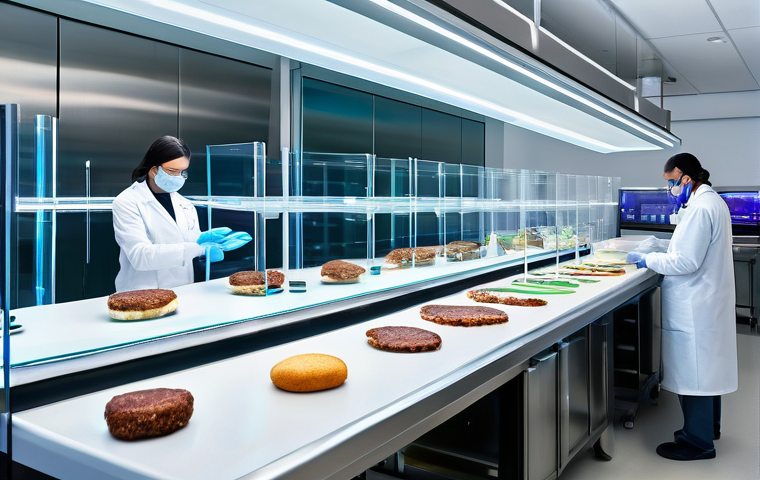
If hydroponics is impressive, then aeroponics takes it up a notch. This method involves suspending plants in the air and misting their exposed roots with a nutrient-rich solution at regular intervals. It’s even more water-efficient than hydroponics, using up to 98% less water than traditional farming. The increased oxygen exposure to the roots also often leads to faster growth rates and even larger yields. I remember seeing an aeroponic tower garden for the first time, with lush greens cascading down its sides, and thinking, “This is the future!” The plants looked unbelievably healthy, almost glowing. Because the roots are directly exposed, they have unrestricted access to oxygen, which is crucial for nutrient uptake and overall plant vitality. It’s a high-tech, highly efficient method that’s perfect for urban environments and offers unparalleled control over the growing process, truly maximizing every drop of water and every bit of nutrient.
Combating the Crisis: Revolutionary Approaches to Food Waste
Let’s be brutally honest: food waste is a colossal problem, a silent drain on our resources, and a stark ethical challenge. Globally, a staggering amount of food never even reaches our plates, rotting away in fields, transport, stores, or even our own refrigerators. It’s not just the food itself that’s wasted; it’s all the water, energy, and labor that went into producing it. I’ve personally felt the pang of guilt tossing out wilted greens, and it makes me think about the bigger picture. Thankfully, some incredible innovations are now tackling this issue head-on, throughout the entire supply chain. From smart packaging that extends shelf life to AI-driven logistics that predict demand more accurately, we’re finally getting serious about making every bite count. This isn’t just about saving money; it’s about respecting our planet and ensuring that food gets to those who need it.
Smart Solutions Along the Supply Chain
The journey from farm to fork is complex, and unfortunately, waste can occur at every single stage. But new technologies are stepping in to plug these leaks. For instance, advanced cold chain logistics ensure produce stays fresh during transport, significantly reducing spoilage. AI-powered inventory management systems help grocery stores order just the right amount of stock, minimizing over-ordering and subsequent waste. Even packaging is getting smarter, with innovations that can naturally extend the shelf life of fruits and vegetables, or indicators that tell you when food is actually bad, rather than relying solely on arbitrary “best by” dates. I’ve seen this firsthand in local markets where digital tracking systems have drastically cut down on discarded produce. These seemingly small changes add up to enormous savings in terms of both food and environmental impact, and it’s truly exciting to witness.
Empowering Consumers to Reduce Waste at Home
While large-scale changes are crucial, we as consumers also play a huge role, and thankfully, new tools are making it easier for us to be part of the solution. Apps that connect you to local restaurants selling surplus food at a discount, smart refrigerator cameras that remind you what you have before you buy more, and innovative food preservation techniques (beyond just freezing!) are all empowering us to waste less. I’ve found that simply planning my meals more carefully and learning how to properly store different foods has made a massive difference in my own kitchen waste. It’s a mindset shift, yes, but technology is making it simpler and more accessible for everyone. Every time I cook with ingredients I might have otherwise thrown out, I feel a little win, knowing I’m doing my part. It’s about building habits that are good for our wallets and even better for the planet.
Cultivating the Oceans: Sustainable Aquaculture Practices
Our oceans are incredible, vast sources of food, but conventional fishing practices have pushed many wild fish populations to the brink. This is where sustainable aquaculture comes in, and I genuinely believe it holds immense promise for feeding the world responsibly. I’ve heard many misconceptions about fish farming, but the reality is that incredible advancements are being made to ensure that farmed seafood is not only healthy for us but also environmentally sound. We’re moving beyond old, problematic methods towards innovative systems that protect marine ecosystems, minimize waste, and provide a reliable source of protein. It’s about taking the pressure off wild stocks and creating a controlled, efficient way to produce seafood. I’ve been so impressed by how some operations are integrating cutting-edge tech to monitor water quality and fish health, making sure everything is just right. It’s a vital step towards a future where our seafood cravings don’t come at the cost of ocean health.
Protecting Our Blue Planet with Smart Farming
The new wave of sustainable aquaculture is all about minimizing environmental impact and actively protecting our marine environments. This means things like closed-containment systems that prevent farmed fish from escaping and interbreeding with wild populations, or discharging untreated waste into sensitive ecosystems. Instead, these systems often filter and recirculate water, reducing pollution and conserving resources. I’ve learned about innovative feed formulations that reduce the reliance on wild-caught fish as feed, instead using sustainable alternatives like algae or insect-based proteins. It’s a holistic approach that considers the entire ecosystem. When I choose sustainably farmed seafood now, I feel much better about my choices, knowing that I’m supporting practices that are actively working to preserve the health and biodiversity of our oceans for generations to come. It truly makes a difference.
Integrated Aquaculture: A Harmony of Species
One of the most exciting developments I’ve witnessed in sustainable aquaculture is the rise of Integrated Multi-Trophic Aquaculture (IMTA). This ingenious system mimics natural ecosystems by culturing different species together, where the waste products of one species become the food or fertilizer for another. For example, fish waste can nourish seaweed, which in turn absorbs excess nutrients and helps purify the water. Shellfish, like mussels or oysters, can also filter water, further enhancing the system’s cleanliness. It’s a beautiful example of circular economy principles applied to farming! I visited an IMTA farm, and it felt like a miniature, thriving underwater ecosystem. The synergy between the different species created a remarkably efficient and environmentally friendly production cycle. This isn’t just about farming fish; it’s about farming an entire ecosystem in a way that’s both productive and incredibly respectful of natural processes. It’s a true testament to biomimicry in action.
Innovation at Our Fingertips: The Tech Shaping Our Food Future
It’s truly mind-boggling to think about how rapidly technology is transforming the very foundation of our existence: food. From the tiny sensors in the soil to the massive data centers processing agricultural insights, we’re seeing an unprecedented convergence of science, tech, and agriculture. I’ve personally witnessed how these innovations aren’t just theoretical; they’re making a tangible difference right now, helping farmers grow more with less, reducing waste, and offering us healthier, more sustainable choices in our grocery aisles. It’s not just about one breakthrough; it’s about an entire ecosystem of advancements working together to create a more resilient and equitable global food system. And honestly, for someone who loves food as much as I do, it’s an incredibly exciting time to be alive, knowing that the future of our plates is looking greener and smarter than ever before.
Bringing Biotech to the Bistro: Microbial and Fermentation Breakthroughs
Beyond the fields and farms, a quiet revolution is brewing in the world of microbes and fermentation. We’re talking about harnessing the power of tiny organisms to create entirely new food products, enhance flavors, and even produce essential nutrients more sustainably. Think about precision fermentation, where microorganisms are essentially reprogrammed to produce specific proteins or fats that can then be used to create dairy-free cheeses, egg whites, or even flavors that would typically come from animals. I’ve tasted some products made with these technologies, and the quality and taste are often indistinguishable from their traditional counterparts. This isn’t just about imitation; it’s about creating food with a dramatically smaller environmental footprint, often using fewer resources and generating less waste. It’s a whole new frontier for sustainable food, proving that sometimes the smallest things can make the biggest impact.
Robotics and Automation: The New Hands in the Fields
The image of a farmer toiling manually in the fields is rapidly evolving, as robotics and automation are becoming increasingly integral to modern agriculture. This isn’t about replacing human farmers but empowering them with tools that can perform tedious, repetitive, or difficult tasks with incredible precision and efficiency. We’re seeing robotic planters that can precisely place seeds, automated harvesting machines that gently pick delicate fruits, and even autonomous tractors that can navigate fields with GPS guidance, optimizing everything from planting to spraying. I’ve seen videos of these robots in action, and they’re truly incredible, reducing labor costs, increasing efficiency, and minimizing resource waste. This allows farmers to focus on higher-level tasks and decision-making, while the robots handle the grunt work. It’s a fascinating blend of human ingenuity and mechanical precision, shaping a more productive and sustainable agricultural landscape for everyone.
| Technology | Key Benefits | Environmental Impact |
|---|---|---|
| Vertical Farming | Local fresh produce, reduced land use, higher yields per square foot | 95% less water, no pesticides, reduced transport emissions |
| Precision Agriculture | Optimized resource use, improved crop health, higher yields | Reduced water, fertilizer, and pesticide use, lower fuel consumption |
| Cultivated Meat | Ethical protein source, reduced animal agriculture footprint | Significantly less land, water, and greenhouse gas emissions |
| Regenerative Farming | Improved soil health, increased biodiversity, climate resilience | Carbon sequestration, reduced erosion, enhanced water retention |
| Hydroponics/Aeroponics | Fast growth, year-round production, space efficiency | 70-98% less water, no soil degradation, reduced chemical inputs |
Wrapping Things Up
It’s truly incredible, isn’t it? As we’ve journeyed through these amazing innovations, I hope you feel as invigorated as I do about the future of our food.
From the gleaming towers of vertical farms to the silent revolution happening in our soil and even the lab, the ingenuity aimed at feeding our world better is truly inspiring.
It’s a testament to human creativity and our collective desire to build a more sustainable, resilient, and delicious future for everyone. Each step forward, big or small, brings us closer to a planet where fresh, nutritious food is accessible to all, without compromising our precious Earth.
Good to Know Info
1. Start Small at Home: You don’t need a huge garden to embrace sustainable eating. Consider a small herb garden on your windowsill, or even a mini hydroponic system for fresh lettuce year-round. It’s incredibly rewarding to grow your own!
2. Support Local & Smart Farms: Look for produce from local vertical farms or farmers practicing regenerative agriculture. Many farmers’ markets now feature vendors highlighting these sustainable methods, offering incredibly fresh and ethically grown options.
3. Become a Food Waste Warrior: Get creative with your leftovers! Explore recipes that use vegetable scraps, proper food storage techniques, and meal planning to drastically cut down on what you throw away. Every little bit truly helps.
4. Explore Alternative Proteins: Don’t be shy about trying plant-based meats, cultivated proteins, or even novel ingredients like mushroom-based alternatives. The flavors and textures have come so far, and they offer a delicious way to reduce your environmental footprint.
5. Educate Yourself and Others: Share what you’ve learned about these food innovations! The more people understand the challenges and solutions in our food system, the more collective action we can inspire towards a healthier planet.
Key Takeaways
The future of food is here, and it’s brimming with innovation! From controlled-environment agriculture like vertical farms and soilless systems offering fresh, local produce with minimal resource use, to precision agriculture optimizing every inch of farmland, technology is revolutionizing how we grow.
We’re also seeing ethical and sustainable protein sources emerge through cultivated meats and diverse plant-based alternatives, significantly reducing the environmental strain of traditional livestock.
Crucially, regenerative farming and agroecology are healing our soil and fostering biodiversity, while smart solutions are tackling the colossal problem of food waste.
Finally, sustainable aquaculture is protecting our oceans, ensuring a reliable seafood supply. These advancements collectively point towards a more resilient, equitable, and sustainable food system for all.
Frequently Asked Questions (FAQ) 📖
Q: Vertical farms sound amazing, but how do they really work, and what makes them so much better for the environment?
A: Oh, this is one of my absolute favorites to talk about! Imagine farming, but instead of sprawling fields, you’ve got these incredible multi-layered systems, often indoors, where crops are stacked vertically.
Think of it like a high-rise apartment building, but for plants! They don’t use soil; instead, they often grow in nutrient-rich water (hydroponics) or a fine mist (aeroponics), which is shockingly efficient.
What makes them an environmental superstar? First, they use significantly less water—I’ve heard figures as high as 95% less than traditional farming because the water is recirculated.
That’s mind-blowing, right? Second, because they’re indoors, they’re not affected by crazy weather, pests, or seasons, meaning fewer pesticides and herbicides are needed.
Plus, they can be built right in the heart of cities, drastically cutting down on “food miles,” so your lettuce isn’t traveling across the country to get to your plate.
It’s fresher, tastier, and way kinder to our planet. I mean, who wouldn’t want that?
Q: You mentioned “precision agriculture.” What exactly is that, and how does it make our food safer and more sustainable?
A: Okay, so if vertical farming is the architect, precision agriculture is the super-smart data scientist of the food world. It’s all about using advanced tech – think GPS, sensors, AI, and even drones – to observe, measure, and respond to individual crop needs.
Instead of treating a whole field uniformly, precision ag tools know exactly what each patch of soil or even individual plant needs. For example, sensors can tell a farmer precisely when and where to apply water, fertilizer, or pest control, rather than just spraying everywhere.
This means less waste, fewer chemicals leaching into our environment, and optimized resource use. From a safety standpoint, knowing exactly what’s going onto our food, and only applying it when and where necessary, gives me so much more peace of mind.
It’s about being incredibly smart and targeted, making farming not just more efficient, but genuinely more mindful of our health and the ecosystem.
Q: This all sounds wonderful, but are these new food technologies actually affordable and accessible for everyday folks like us?
A: That’s such a crucial question, and honestly, one I hear a lot! When I first started looking into these innovations, I wondered the same thing. While some of these technologies are still scaling up and require initial investment, the long-term trends are really promising for accessibility.
As the technology matures and becomes more widespread, the costs are coming down. Think about it: reduced water, less land, fewer pesticides, and localized production all contribute to lower operational costs over time.
We’re already seeing vertically farmed greens appearing in mainstream grocery stores, often competitively priced, and the quality is fantastic! Plus, the push for local food systems means that communities are actively exploring how to integrate these solutions, making fresh, sustainable food more available to everyone, not just those in big cities.
It’s not an overnight switch, but I genuinely believe we’re heading towards a future where healthy, sustainably grown food is within reach for more and more of us.
It’s an exciting time to be a food lover, that’s for sure!
📚 References
Wikipedia Encyclopedia
구글 검색 결과
구글 검색 결과
구글 검색 결과
구글 검색 결과
구글 검색 결과
